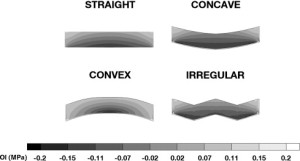LSJL upregulates Cftr. Although other than the name I can’t find a connection between this gene and Cfm1 and Cfm2.
According to Hierarchical fine mapping of the cystic fibrosis modifier locus on 19q13 identifies an association with two elements near the genes CEACAM3 and CEACAM6., Cfm1 is located on the same gene as Tgfb1 a height increase gene. “seven microsatellite markers on 19q13 spanning a 4.8-Mb genomic area encompassing both, TGFB1 and CFM1”
“Cystic fibrosis (CF) is an autosomal-recessively inherited disease transmitted by two defective copies of the cystic fibrosis transmembrane conductance regulator gene (CFTR). The disease manifests as a generalized exocrinopathy, affecting all tissues that express the chloride and bicarbonate channel CFTR ”
Cystic fibrosis can result in shorter height.
Filamin-interacting proteins, Cfm1 and Cfm2, are essential for the formation of cartilaginous skeletal elements.
“Mutations of Filamin genes, which encode actin-binding proteins, cause skeletal abnormalities. The molecular mechanisms underlying Filamin functions in skeletal system formation remain elusive. In our screen to identify skeletal development molecules, we found that Cfm (Fam101) genes, Cfm1 (Fam101b) and Cfm2 (Fam101a), are predominantly co-expressed in developing cartilage and intervertebral discs (IVDs). To investigate the functional role of Cfm genes in skeletal development, we generated single knockout mice for Cfm1 and Cfm2, as well as Cfm1/Cfm2 double-knockout (Cfm DKO) mice, by targeted gene disruption. Mice with loss of a single Cfm gene displayed no overt phenotype, whereas Cfm DKO mice showed skeletal malformations including spinal curvatures, vertebral fusions, and impairment of bone growth, showing that the phenotypes of Cfm DKO mice resemble those of Filamin B (Flnb)-deficient mice. The number of cartilaginous cells in IVDs is remarkably reduced, and chondrocytes are moderately reduced in Cfm DKO mice. We observed increased apoptosis and decreased proliferation in Cfm DKO cartilaginous cells. In addition to direct interaction between Cfm and Filamin proteins in developing chondrocytes, Cfm is required for the interaction between Flnb and Smad3, which [regulates] Runx2 expression. Cfm DKO primary chondrocytes showed decreased cellular size and fewer actin bundles compared to those of wild-type chondrocytes. Cfms are essential partner molecules of Flnb in regulating differentiation and proliferation of chondryocytes and actin dynamics.”
“Inhibitors of actin polymerization stimulate chondrocyte differentiation in cultured mesenchymal cells and murine embryonic stem cells”
“mouse Cfm2 transcripts markedly increased in ATDC5 cells upon differentiation.”
“The CR length and tibial length of Cfm DKO mice were significantly shorter than those of wild-type, Cfm+/−/Cfm2−/−, and Cfm1−/− / Cfm2+/− mice at 4 weeks”
“Cfm1 and Cfm2 bind to Filamins (Flna, Flnb and Flnc)”<-LSJL upregulates Filamin C.
“Flna and Flnb are expressed in chondrocytes”
“Cfm1 and Cfm2 regulate chondrocyte survival and proliferation, and interact with Filamins. Cfms interacted with Filamins to organize perinuclear actin networks and regulated nuclear shape”
“Cfm is required for the interaction between Flnb and Smad3 in chondrocytes, and the Flnb-Cfm-Smad3 complex may play an important role in chondrogenesis.”
“Flnb normally prevents excessive Smad3 phosphorylation.”
“TGF-β1 stimulation up-regulated Cfm1 protein expression, but Cfm2 protein and mRNA were below detection level in an epithelial cell line”

